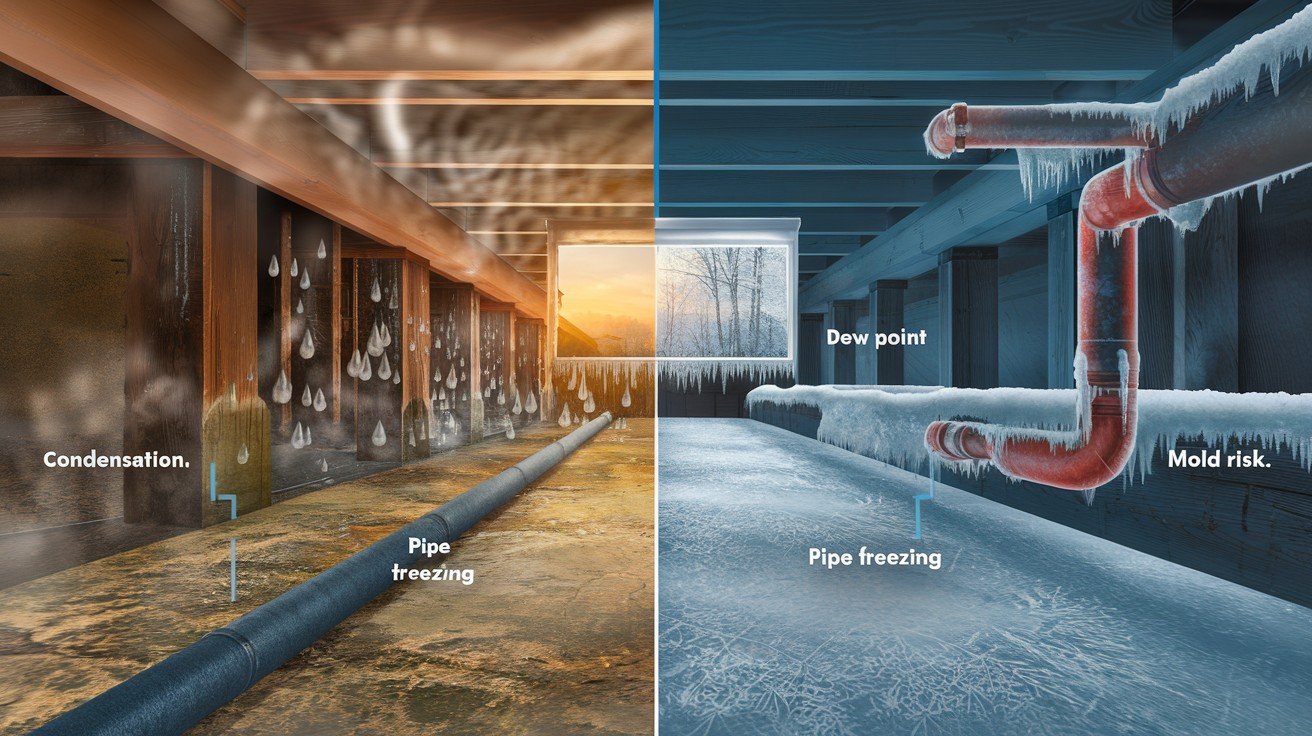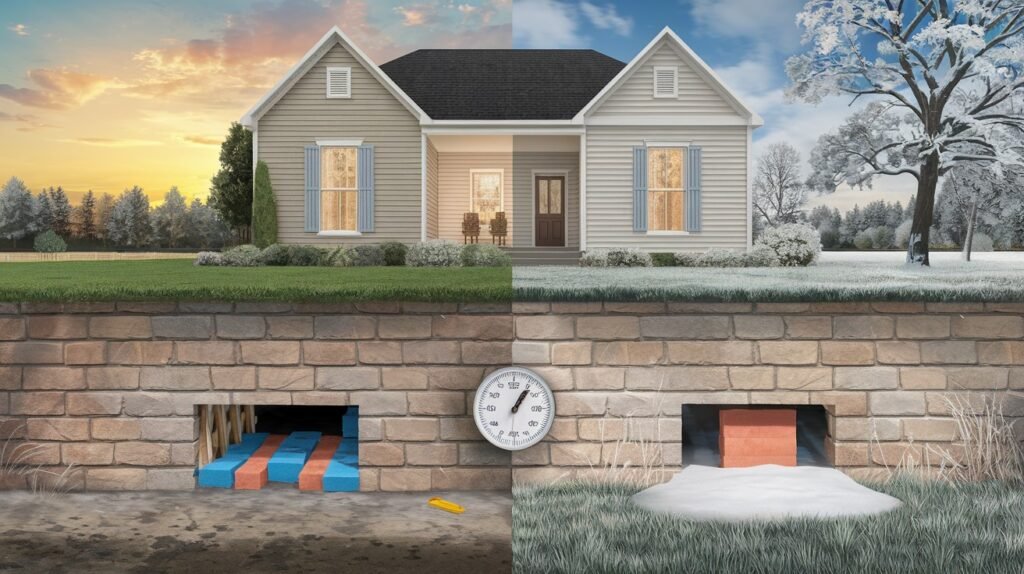When chilly weather starts rolling in, homeowners face a common question: what temperature to I close crawl space vents?
Getting this timing wrong can lead to frozen pipes, sky-high energy bills, and uncomfortable cold floors that make winter mornings even more miserable.
Most experts agree that once outdoor temperatures consistently drop below 40°F (4°C), it’s time to seal those vents.
But there’s more to it than just watching the thermometer. Your local climate, your home’s insulation, and even humidity levels all play a role in making this decision.
Don’t worry, we’ve got you covered with a straightforward guide that takes the guesswork out of seasonal vent management.
You’ll learn exactly when to close them, how to do it properly, and smart alternatives that could save you money long-term.
The Purpose of Crawl Space Vents
Crawl space vents were originally designed to promote air circulation and prevent moisture from accumulating underneath your home.
The traditional approach suggests opening them during warmer months to allow airflow and closing them when temperatures drop to protect against cold air infiltration.
However, your regional climate plays a crucial role in determining the best venting strategy.
Homes in humid southern climates face different challenges than those in dry, cold northern regions, making a one-size-fits-all approach less effective for optimal moisture control.
Why Temperature Matters?

Temperature directly affects moisture behavior in your crawl space, making it a critical factor in vent management decisions.
When warm, humid air meets cold surfaces, condensation forms, creating ideal conditions for mold growth and wood rot. The dew point helps predict when this moisture problem will occur.
Cold outdoor air entering through open vents can freeze pipes and create uncomfortable temperature differences between your crawl space and living areas.
Understanding these temperature dynamics helps you make informed decisions about when to open or close vents for optimal home protection.
- Condensation Formation: When warm, humid air meets cold surfaces in your crawl space, it creates condensation that can damage wood structures and promote mold growth. This moisture buildup becomes especially problematic when outdoor temperatures fluctuate rapidly.
- Pipe Freezing Risk: Cold air entering through open vents can cause water pipes to freeze and burst, leading to costly repairs and water damage. Maintaining stable temperatures in your crawl space protects your plumbing system during the winter months.
- Dew Point Science: The dew point is the temperature at which air becomes saturated and moisture condenses. Understanding this helps you predict when closing vents will prevent humid outdoor air from creating moisture problems inside your crawl space.
- Temperature Differential Impact: Large differences between outdoor and crawl space temperatures can create air pressure changes that draw unwanted moisture into your home. This temperature gap affects both energy efficiency and indoor comfort levels.
- Mold Growth Conditions: Temperatures between 60-80°F combined with high humidity create ideal conditions for mold and mildew. Controlling temperature through proper vent management helps maintain a healthier environment in your home.
What Temperature to Close Crawl Space Vents?
The general rule of thumb is to close crawl space vents when outdoor temperatures consistently drop below 40°F (4°C).
This threshold helps protect your home from cold-weather complications while maintaining reasonable energy efficiency.
Leaving vents open during cold weather creates several costly problems. Frozen pipes can burst and cause thousands in water damage, while cold air infiltration makes your floors uncomfortably chilly and forces your heating system to work overtime, significantly increasing energy bills.
Regional climate considerations matter significantly in your decision-making process.
Homes in mild winter regions might only need seasonal closure for a few months, while those in harsh winter climates may benefit from closing vents earlier in fall and keeping them sealed longer into spring.
Areas with extreme temperature swings require more careful monitoring to prevent rapid freeze-thaw cycles that can damage both pipes and structural components underneath your home.
Signs It’s Time to Close the Vents
|
Warning Sign |
What to Look For |
Why It Matters |
|
Cold Nighttime Temperatures |
Outdoor temps consistently dropping below 40°F at night |
Even if daytime is warm, cold nights can freeze pipes and create moisture problems |
|
HVAC System Overworking |
The heating system is running more frequently or longer cycles |
Cold air infiltration forces your system to work harder, increasing energy costs |
|
Indoor Comfort Issues |
Cold drafts near floors or increased dampness/humidity indoors |
Open vents allow cold, moist air to enter, affecting both comfort and air quality |
Seasonal Vent Strategy: When to Open vs. Close
Fall/Winter Strategy
Close vents as temperatures drop below 40°F to prevent cold air infiltration and protect pipes from freezing.
This seasonal closure also helps maintain indoor comfort by preventing cold drafts from entering through floor spaces.
Spring/Summer Strategy
Open vents selectively based on humidity levels rather than automatically. In dry climates, opening vents can provide beneficial air circulation.
However, in humid regions, open vents may introduce more moisture problems than they solve.
Modern Expert Recommendations
Many professionals now advocate for permanent vent sealing combined with comprehensive moisture control systems.
Crawl space encapsulation with vapor barriers and dehumidifiers provides year-round moisture management without the guesswork of seasonal opening and closing.
This approach eliminates temperature-related decisions while offering superior humidity control and energy efficiency compared to traditional venting methods.
Conclusion
Managing crawl space vents by temperature is a straightforward yet important aspect of home maintenance that can save you from costly repairs and uncomfortable living conditions.
Remember the key threshold: close vents when temperatures consistently drop below 40°F to protect your pipes, floors, and energy bills.
Pay attention to warning signs like increased HVAC usage and cold drafts, as these indicate it’s time to take action.
While seasonal opening and closing work for many homes, consider modern alternatives like crawl space encapsulation if you’re tired of the twice-yearly routine.
The investment in proper crawl space management pays dividends through lower energy costs, improved comfort, and protection against freeze damage.
Take control of your home’s foundation climate, and you’ll enjoy a more comfortable, efficient living space year-round while avoiding expensive surprises.
Frequently Asked Questions
At what temperature should I close the crawl space vents?
Close vents when outdoor temperatures consistently drop below 40°F (4°C) to prevent pipe freezing and cold air infiltration.
Can I leave vents open all winter?
No, open vents during winter can cause frozen pipes, cold floors, and significantly higher heating bills throughout the season.
When should I open vents in spring?
Open vents when nighttime temperatures stay above 40°F consistently, but consider local humidity levels before making the decision.
Do all regions follow the same temperature rule?
No, mild winter regions may close vents later, while harsh winter areas should close earlier for protection.
What if I forget to close them?
Close them immediately when you remember. Even late closure provides some protection against pipe damage and energy loss.
Should vents stay closed year-round?
Some experts recommend permanent sealing with proper moisture control systems, like dehumidifiers, for better overall performance and efficiency.

